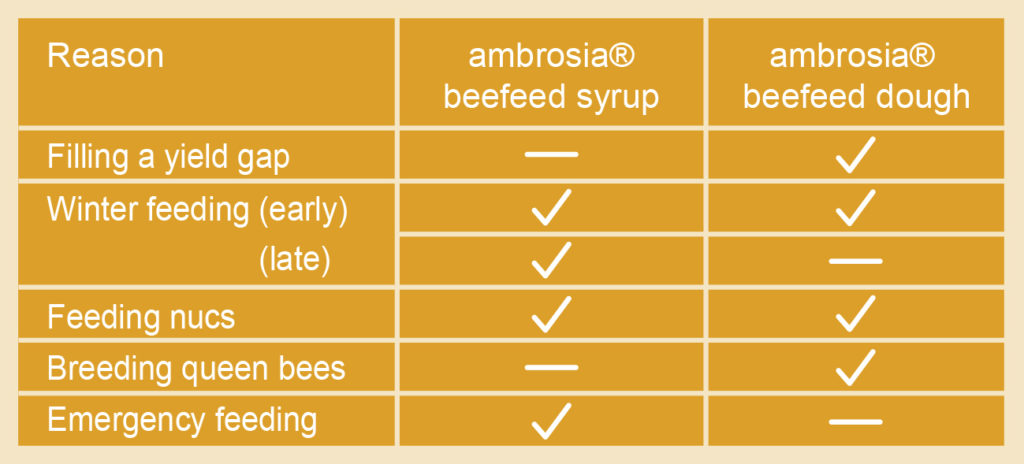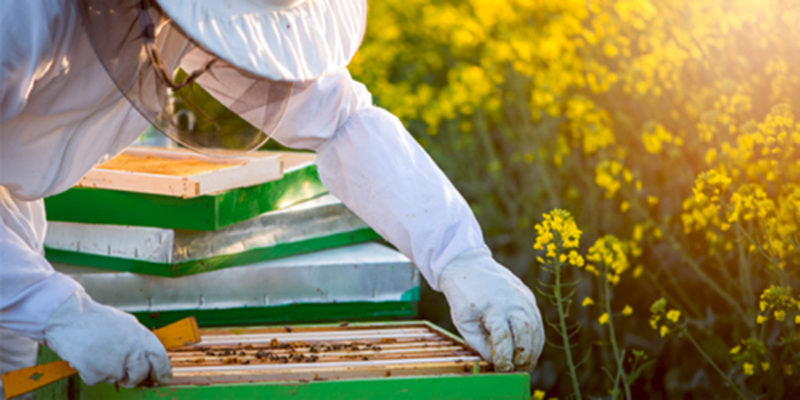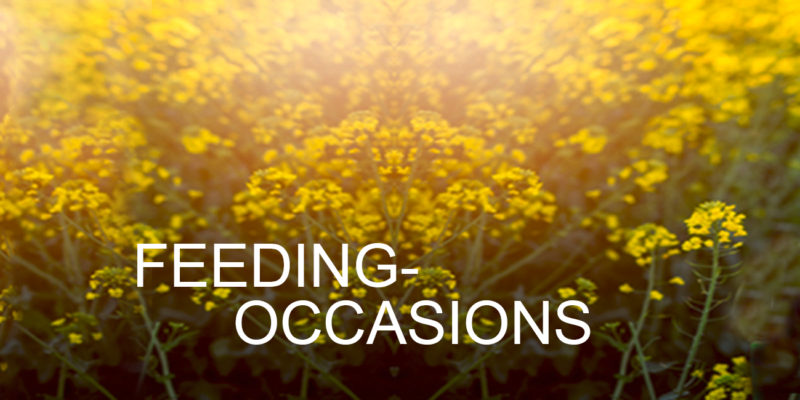Reasons for feeding
Maintenance feeding
In the spring, the increasing day length, rising temperatures and available pollen provide stimulus and drive for rapid growth in bee populations. An abundance of food is needed in order to stock up for the winter. If food is not abundant, it is a good measure to provide ambrosia® bee feed syrup as a precaution.
Emergency feeding
If the colony is suffering from hunger, little food is available, the bees move very sluggishly and some are already falling through the frame spaces to the hive bottom. An immediate measure is to provide 0,5 litres of ambrosia® bee food syrup at body temperature near the hive. The bees will be mobile again after just 2 hours. An emergency situation always results in a developmental setback, so an economic impact cannot be ruled out. If you notice food shortages among individual populations in late winter, remove the empty honeycombs around the borders up to where the bees are hibernating and fill the gaps with foodcombs or honeycombs from better-stocked populations in the same location. Alternatively, you will need to feed them with warmed ambrosia® bee feed syrup overnight in feed bags. It is important to provide a food supply of at least 5 kg (corresponds to three full honeycombs).
If there is a risk that the feeder will not be visited, the syrup should be filled in a clean twist-off jar with small holes in the lid. An empty super should be placed on the upper super of the colony and the jar with syrup should be placed upside down directly on the frames above the winter cluster.
In the early spring, before preparing the honey is attached and in favorable weather, it is essential to supplement the feed with 2-3 liters of ambrosia® bee food syrup.
Harvest-gap feeding
Providing ambrosia® bee feed fondant in the practical 2,5-kg single-serving packages can help bees through the critical phase until harvest time.
If you can assume that the nectar flow will start again soon, it is better to feed with honey to avoid transferring feed to the new honey. This honey should be from your own beekeeping to avoid transfer of germs.
Feeding nucleus colonies
Nucs provide a guarantee and back up for the coming season. Brood comb colonies are formed at the start of the rape seed or dandelion blossoming season so Mother Nature can help provide them with plenty of nectar and pollen. However, the weather often does not play along, for instance if rainy or cold periods reduce harvesting and flying opportunities.
If there is a yield, you do not need to feed the nucs. Otherwise, they should be provided with a single-serving package of ambrosia® bee feed fondant every 8 to 10 days. It is less work, and the steady flow of feed helps the young population develop quickly. With appropriate care and growth, the nucs should have two 20-DN frames or Zander combs by the end of July. Supplemental feeding with ambrosia® bee feed fondant takes place starting at the end of July. Only well-stocked nucs with a vital queen can guarantee successful hibernation and full capacity in the next season.
Breeding queen bees
3 to 6 weeks before the start of breeding, the attendants are bred and hatched. First, a good pollen yield from dandelion, oilseed rape or similar plants must have given the bee populations a large breeding area. The optimal breeding of nurse bees is one of the most important requirements to ensure good acceptance of queen cells and care of the breeding material.
Stocking up the winter supply – 3 options
Depending on the type of operation and the beekeeper’s needs, the following options are available:
Option 1: ambrosia® bee feed fondant
Provide an entire package of 15 kg Pakets ambrosia® bee feed fondant. To do so, remove the cover of the package and place it upside down so the removal surface is directly on the frame over the bee cluster. Cover with an empty super and hive cover. After 10 to 14 days, when the fondant is consumed, add another half package. Together with the 3 kg honey supply left behind, that gives the colony their full ration, so they are ready for winter by mid-August. Any later supplemental feedings should only use ambrosia® bee feed syrup. The major benefit of this option is the long-lasting food supply for the bees and labour efficiency for you. No feed is spilled, which also reduces the risk of robbing. This results in well-cared-for, uncontaminated and well-developed winter bees.
Option 2: ambrosia® bee feed fondant and syrup
First, a full package is provided as described above; since the forager bees remain active during fondant feeding and the breeding activity is maintained as a result, this has a physiologically more favourable effect on the quality of the emerging winter bees than liquid feeding. In late August to early September, the remaining amount is supplemented with 8 to 10 liters of ambrosia® bee food syrup.
Option 3: exclusively ambrosia® bee feed syrup
The rule of thumb: large servings for large colonies, small servings for small colonies. The syrup’s benefits come from its optimal composition and the ease with which bees can process it when they are fed later due to heather or pine yields.
Late winter feeding takes place from mid-September to mid / end October. Feeding the bees 17 litres of syrup helps easily supply the colony until the next springtime. Tests with sugar water and ambrosia® bee feed syrup showed that colonies fed with syrup were able to finish preparing and capping their winter feed 3 to 6 days sooner.

We gladly answer your questions and recommend a specialized local retailer.


